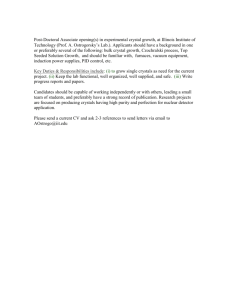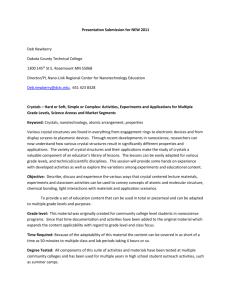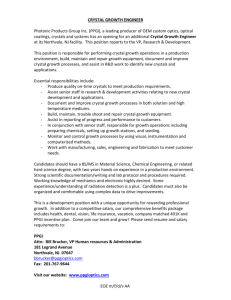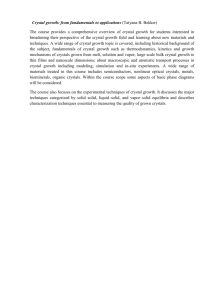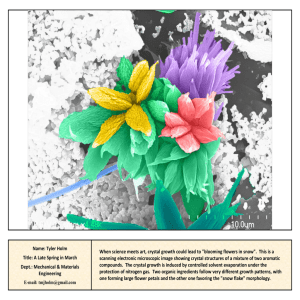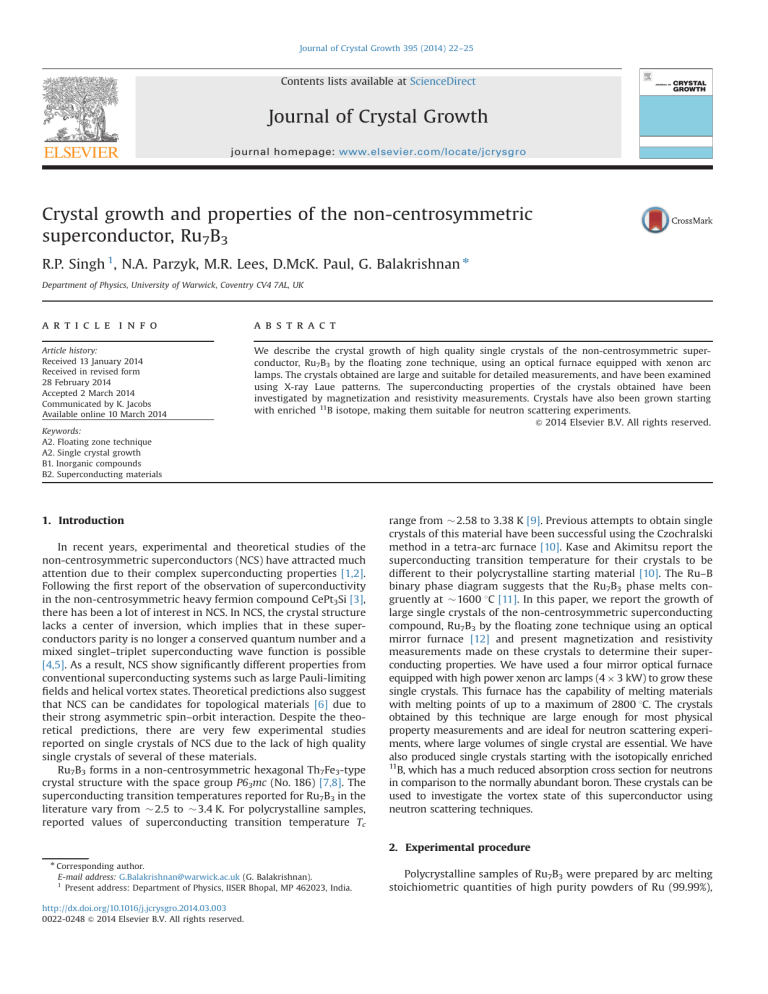
Journal of Crystal Growth 395 (2014) 22–25
Contents lists available at ScienceDirect
Journal of Crystal Growth
journal homepage: www.elsevier.com/locate/jcrysgro
Crystal growth and properties of the non-centrosymmetric
superconductor, Ru7B3
R.P. Singh 1, N.A. Parzyk, M.R. Lees, D.McK. Paul, G. Balakrishnan n
Department of Physics, University of Warwick, Coventry CV4 7AL, UK
art ic l e i nf o
a b s t r a c t
Article history:
Received 13 January 2014
Received in revised form
28 February 2014
Accepted 2 March 2014
Communicated by K. Jacobs
Available online 10 March 2014
We describe the crystal growth of high quality single crystals of the non-centrosymmetric superconductor, Ru7B3 by the floating zone technique, using an optical furnace equipped with xenon arc
lamps. The crystals obtained are large and suitable for detailed measurements, and have been examined
using X-ray Laue patterns. The superconducting properties of the crystals obtained have been
investigated by magnetization and resistivity measurements. Crystals have also been grown starting
with enriched 11B isotope, making them suitable for neutron scattering experiments.
& 2014 Elsevier B.V. All rights reserved.
Keywords:
A2. Floating zone technique
A2. Single crystal growth
B1. Inorganic compounds
B2. Superconducting materials
1. Introduction
In recent years, experimental and theoretical studies of the
non-centrosymmetric superconductors (NCS) have attracted much
attention due to their complex superconducting properties [1,2].
Following the first report of the observation of superconductivity
in the non-centrosymmetric heavy fermion compound CePt3Si [3],
there has been a lot of interest in NCS. In NCS, the crystal structure
lacks a center of inversion, which implies that in these superconductors parity is no longer a conserved quantum number and a
mixed singlet–triplet superconducting wave function is possible
[4,5]. As a result, NCS show significantly different properties from
conventional superconducting systems such as large Pauli-limiting
fields and helical vortex states. Theoretical predictions also suggest
that NCS can be candidates for topological materials [6] due to
their strong asymmetric spin–orbit interaction. Despite the theoretical predictions, there are very few experimental studies
reported on single crystals of NCS due to the lack of high quality
single crystals of several of these materials.
Ru7B3 forms in a non-centrosymmetric hexagonal Th7Fe3-type
crystal structure with the space group P63mc (No. 186) [7,8]. The
superconducting transition temperatures reported for Ru7B3 in the
literature vary from 2.5 to 3.4 K. For polycrystalline samples,
reported values of superconducting transition temperature Tc
range from 2.58 to 3.38 K [9]. Previous attempts to obtain single
crystals of this material have been successful using the Czochralski
method in a tetra-arc furnace [10]. Kase and Akimitsu report the
superconducting transition temperature for their crystals to be
different to their polycrystalline starting material [10]. The Ru–B
binary phase diagram suggests that the Ru7B3 phase melts congruently at 1600 1C [11]. In this paper, we report the growth of
large single crystals of the non-centrosymmetric superconducting
compound, Ru7B3 by the floating zone technique using an optical
mirror furnace [12] and present magnetization and resistivity
measurements made on these crystals to determine their superconducting properties. We have used a four mirror optical furnace
equipped with high power xenon arc lamps (4 3 kW) to grow these
single crystals. This furnace has the capability of melting materials
with melting points of up to a maximum of 2800 1C. The crystals
obtained by this technique are large enough for most physical
property measurements and are ideal for neutron scattering experiments, where large volumes of single crystal are essential. We have
also produced single crystals starting with the isotopically enriched
11
B, which has a much reduced absorption cross section for neutrons
in comparison to the normally abundant boron. These crystals can be
used to investigate the vortex state of this superconductor using
neutron scattering techniques.
2. Experimental procedure
n
Corresponding author.
E-mail address: G.Balakrishnan@warwick.ac.uk (G. Balakrishnan).
1
Present address: Department of Physics, IISER Bhopal, MP 462023, India.
http://dx.doi.org/10.1016/j.jcrysgro.2014.03.003
0022-0248 & 2014 Elsevier B.V. All rights reserved.
Polycrystalline samples of Ru7B3 were prepared by arc melting
stoichiometric quantities of high purity powders of Ru (99.99%),
R.P. Singh et al. / Journal of Crystal Growth 395 (2014) 22–25
and either B (99.9%) or enriched boron isotope 11B (99.52 At%), on
a water cooled copper hearth under a high purity argon gas (5N)
atmosphere in a tri arc furnace (Centorr, USA). To ensure phase
homogeneity, the resulting buttons were remelted and flipped
several times. The observed weight loss during the melting was
negligible. The phase purity of the polycrystalline buttons was
checked by powder X-ray diffraction. Several polycrystalline buttons obtained in this manner were used to cast rods ( 40 mm in
length and 6 mm in diameter) under flowing argon gas in a triarc furnace. Two different types of feed rods were made, one set of
rods starting with B and another set made starting with 11B. These
rods were used as feed rods for the crystal growth in a high
temperature optical furnace equipped with four 3 kW xenon arc
lamps (CSI Model FZT-1200-X-VI VP). The first crystal growth was
carried out using a tungsten rod as the seed rod and a crystal
obtained from the initial growths was used as the seed for
subsequent growths. Prior to starting the crystal growth, the
growth chamber was flushed several times with high purity argon
gas and then evacuated to a vacuum of 10 6 mbar and finally
filled with argon gas to a pressure of 0.3 MPa for the growth. The
crystal growth was carried out under a flow (1 l/min) of high
purity argon gas. The feed and seed rods were counter rotated at
25–30 rpm and crystal growths were carried out at speeds of
3–6 mm/h. Crystals of Ru711B3 with the isotopically enriched boron
were grown under similar growth conditions.
The crystal boules produced were first examined using Laue
X-ray (Cu) diffraction to check the quality of the crystals. Spark
erosion was used to cut slices from the grown boule for subsequent measurements. Temperature and field dependent magnetization measurements were made in the temperature range
1.8–300 K, using a Quantum Design MPMS-5S SQUID magnetometer. AC resistivity measurements in the temperature range
1.8–300 K were carried out on rectangular bar shaped samples
( 4 mm in length and 2 1 mm2 in cross section) by the standard
four-probe technique using a Quantum Design Physical Property
Measurement System (PPMS).
3. Results and discussion
Ru7B3 melts congruently and therefore lends itself to crystal
growth by the floating zone method. The crystals obtained starting
with both the 11B as well as the 10 B were identical in appearance
and both the boules had shiny surfaces with a golden lustre.
Crystals about 40–50 mm long and roughly 4–6 mm in diameter
were obtained. As the melting temperature for this material is
around 1600 1C, the power of the xenon lamps required to
Fig. 1. (a) Single crystal of Ru7B3. (b) Laue X-ray diffraction pattern of a piece cut
out of the as grown boule along the [100] direction.
23
Fig. 2. Temperature dependence of the magnetic susceptibility (χ dc ) of (a) polycrystalline Ru7B3, and (b) single crystal Ru7B3. The magnetic susceptibility was
measured in an applied field of 10 Oe. For the single crystal, the field was applied
parallel to the [001] (red circles) or [100] (blue squares) directions of the crystal.
Measurements were carried out in both zero field cooled (ZFC) and field cooled (FC)
modes. (For interpretation of the references to color in this figure caption, the
reader is referred to the web version of this paper.)
maintain a stable molten zone was in the region of 15–20%.
We found that in order to obtain the best crystals, slow growth rates
of around 3 mm/h were necessary. There was evidence of boron
evaporation during the growth process in all the growths conducted.
The crystals were cut using a spark cutter. Prior to cutting, the crystals
were examined using Laue X-ray back reflection. Laue X-ray photographs were taken along the length of each crystal on several faces to
confirm the crystal quality. A photograph of the as grown Ru7B3
crystal is shown in Fig. 1(a). The Laue X-ray pattern obtained on a
piece of the crystal cut out of the boule for measurements along the
[100] direction is shown in Fig. 1(b). By use of the Laue X-ray
diffraction, crystals oriented along particular crystallographic axes
were cut from the as-grown boules for measurements.
Fig. 2 shows the dc magnetic susceptibility as a function of
temperature for a crystal of Ru7B3 as well as for a piece of
polycrystalline sample of Ru7B3. The onset of the superconducting
transition T onset
for the single crystal, determined from the dc
c
magnetic susceptibility measurements, is 2.6 K. This is different to
the T onset
of 3.2 K measured on the polycrystalline ingots used as
c
the starting material for the crystal growth. Similar differences
have also been reported between the Tcs of single crystal and
polycrystalline material by Kase and Akimitsu [10] for crystals
grown by the Czochralski technique. In borides, this is often
associated with loss of boron during the crystal growth procedure
and the presence of boron vacancies in the resultant crystals [13].
In general there is good agreement between the observed transition temperatures and those reported on both polycrystalline
samples as well as single crystals grown by the Czochralski
24
R.P. Singh et al. / Journal of Crystal Growth 395 (2014) 22–25
method [10]. Magnetization measurements have been made with
a magnetic field applied along two different orientations, [100]
and [001].
Fig. 3. Temperature dependence of the lower critical field Hc1 for Ru7B3. Measurements were taken with the applied magnetic field parallel to the [100] (blue
squares) and [001] (red circles) directions of the single crystal. The lines are a fit to
the data using a parabolic T dependence of Hc1 (described in the text). The best fit
values of Hc1(0) are 30(2) Oe for the [100] direction and 43(2) Oe for the [001]
direction. (For interpretation of the references to color in this figure caption, the
reader is referred to the web version of this paper.)
Fig. 4. (a) Temperature dependence of the resistivity of Ru7B3. The Ru7B3 single
crystal shows a superconducting transition with T zero
¼ 2:5 K. Also shown is the
c
transition observed for the isotopically enriched crystal, 11B (see text).
(b) Temperature dependence of the resistivity of the Ru7B3 crystal, measured in
increasing magnetic fields applied parallel to the [100] direction.
The lower critical field for single crystal Ru7B3 was estimated by
measuring the magnetization ðMÞ as a function of applied magnetic field ðHÞ at various temperatures and determining the field at
which each M(H) curve deviated from linearity. The T dependence
of Hc1 determined from these measurements is shown in Fig. 3 for
two different orientations, [100] and [001]. Assuming a simple
parabolic T dependence for H c1 ðTÞ ¼ H c1 ð0Þ (1 t2) where t ¼ T=T c ,
we estimate H c1 ð0Þ to be of the order of 30(2) Oe for the [100]
direction and 43(2) Oe for the [001]. A comparison of our estimates of H c1 ð0Þ with the previously reported values for the crystal
obtained by Kase and Akimitsu [10], of 68 and 53 Oe respectively,
shows that our values are slightly lower but the degree of
anisotropy observed in both cases is similar ( 1.3–1.4).
The superconducting transition measured by resistivity measurements on the crystal of Ru7B3 is shown in Fig. 4(a). Also shown
is the resistive transition measured on a crystal made starting with
the enriched boron isotope, 11B. We find that the T onset
for the
c
crystal grown using 11B isotope is different (2.8 K) to that observed
in the crystal grown using 10B. Again, this is attributed to the
slightly different boron losses encountered during the crystal
growth process for the two crystals.
The resistive transitions observed in an applied magnetic field
are shown in Fig. 4. We observe a gradual reduction in the onset of
the superconducting transition as the applied field is increased.
The T zero
obtained from these curves have been used to determine
c
H c2 ðTÞ for the two different directions of the applied field, [100]
and [001]. We find that the initial slope of the Hc2 versus T curve
for both the crystal orientations investigated does not lend itself to
fitting with the Werthamer, Helfand and Honenberg (WHH) model
[14,15]. This is similar to the conclusions of Fang et al. [9] for their
polycrystalline sample, where fits to both the WHH and the
Ginzburg–Landau (GL) models fail, and Kase and Akimitsu [10],
where the WHH model does not fit their data for a single crystal.
Forcing a fit to our data using the WHH model, we estimate H c2 ð0Þ
to be 9.5 and 16 kOe for the [100] and the [001] directions,
respectively (see Fig. 5). We observe a greater degree of anisotropy
in our Hc2(0) values than Kase and Akimitsu [10] who estimated
H c2 ð0Þ values of 15.8 and 17.2 kOe for the [100] and the [001]
directions, respectively, using a GL model. Fang et al. [9] report a
value of 11 kOe for a polycrystalline sample. Clearly the temperature dependence of the H c2 ðTÞ curves requires further detailed
analysis.
Fig. 5. Temperature dependence of the upper critical field H c2 ðTÞ of single crystal
Ru7B3. Measurements were taken with a magnetic field applied parallel to the [100]
(blue squares) and [001] (red circles) directions of the single crystal. T was
determined from T zero
. The lines are a fit to the data using a WHH model. The
c
experimental data deviate significantly from this model (details in the text).
(For interpretation of the references to color in this figure caption, the reader is
referred to the web version of this paper.)
R.P. Singh et al. / Journal of Crystal Growth 395 (2014) 22–25
25
4. Summary and conclusions
References
We have successfully produced large single crystals of Ru7B3 by
the floating zone technique, using an optical furnace equipped with
xenon arc lamps. Examination of the crystals by Laue X-ray diffraction indicates that the quality of the crystals is good. Crystals of large
volume, free of any contamination can be produced by this technique. The crystals exhibit a superconducting transition at 2.6 K.
Crystals have also been obtained by the same technique using
isotopically enriched 11B for use in neutron scattering experiments
to probe the vortex state of these superconductors.
[1] M. Sigrist, D. Agterberg, P. Frigeri, N. Hayashi, R. Kaur, A. Koga, I. Milat,
K. Wakabayashi, Y. Yanase, J. Magn. Magn. Mater. 310 (2007) 536–540.
[2] E. Bauer, M. Sigrist, Non-Centrosymmetric Superconductors: Introduction and
Overview, Springer-Verlag, Berlin, Heidelberg, 2012.
[3] E. Bauer, G. Hilscher, H. Michor, C. Paul, E.W. Scheidt, A. Gribanov,
Y. Seropegin, H. Noël, M. Sigrist, P. Rogl, Phys. Rev. Lett. 92 (2004) 027003.
[4] A.D. Hillier, J. Quintanilla, R. Cywinski, Phys. Rev. Lett. 102 (2009) 117007.
[5] G.M. Luke, Y. Fudamoto, K.M. Kojima, M.I. Larkin, J. Merrin, B. Nachumi,
Y.J. Uemura, Y. Maeno, Z.Q. Mao, Y. Mori, H. Nakamura, M. Sigrist, Nature 394
(1998) 558–561.
[6] M. Sato, S. Fujimoto, Phys. Rev. B 79 (2009) 094504.
[7] B. Aronsson, Acta Chem. Scand. 13 (1959) 109–114.
[8] B. Matthias, V. Compton, E. Corenzwit, J. Phys. Chem. Solids 19 (1961) 130–133.
[9] L. Fang, H. Yang, X. Zhu, G. Mu, Z.-S. Wang, L. Shan, C. Ren, H.-H. Wen, Phys.
Rev. B 79 (2009) 144509.
[10] N. Kase, J. Akimitsu, J. Phys. Soc. Jap. 78 (2009) 044710.
[11] T. Massalski (Ed.), Binary Alloy Phase Diagrams, ASM International, Metals
Park, Ohio, 1986.
[12] R. Singh, M. Smidman, M. Lees, D. Paul, G. Balakrishnan, J. Cryst. Growth 361
(2012) 129–131.
[13] G. Balakrishnan, M. Lees, D. Paul, J. Cryst. Growth 256 (2003) 206–209.
[14] E. Helfand, N.R. Werthamer, Phys. Rev. 147 (1966) 288–294.
[15] N.R. Werthamer, E. Helfand, P.C. Hohenberg, Phys. Rev. 147 (1966) 295–302.
Acknowledgments
We acknowledge the EPSRC, UK for providing funding (grant
number EP/I007210/1). We thank T.E. Orton for technical support
and A.D. Hillier (ISIS, STFC, UK) for helpful discussions. Some of the
equipment used in this research at the University of Warwick was
obtained through the Science City Advanced Materials: Creating
and Characterising Next Generation Advanced Materials Project,
with support from Advantage West Midlands (AWM) and part
funded by the European Regional Development Fund (ERDF).

